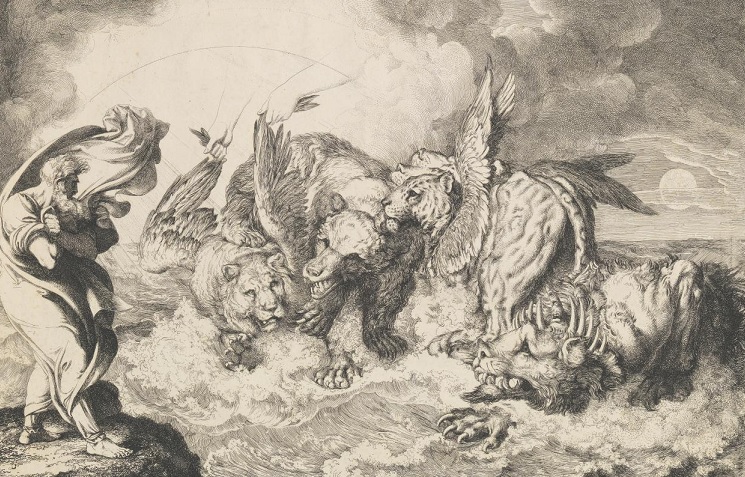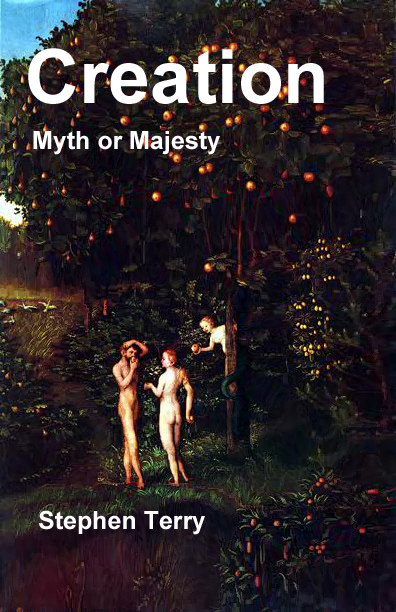
Stephen
Terry, Director

The Bible and Prophecy
Commentary
for the June 13, 2020 Sabbath School Lesson
 "Above all, you must understand that no prophecy of
Scripture came about by the prophet's own interpretation of things. For
prophecy never had its origin in the human will, but prophets, though human,
spoke from God as they were carried along by the Holy Spirit." 1 Peter 1:20-21,
NIV
"Above all, you must understand that no prophecy of
Scripture came about by the prophet's own interpretation of things. For
prophecy never had its origin in the human will, but prophets, though human,
spoke from God as they were carried along by the Holy Spirit." 1 Peter 1:20-21,
NIV
Since this week's lesson is merely a rehash of the
entire first quarter of 2020, we will review point by point some of the points
made in previous commentaries I published for that quarter and reiterated in my
book, "Commentary on the Book of Daniel." [i]
The purpose of such a response is to illustrate that 1) there may be other possible
interpretations for the material presented in this week's lesson and 2) a
reminder that we are not save by prophetic perspective but by the grace of God
through Jesus Christ.
Although not mentioned in this week's lesson, an
easy example is found in Daniel, chapter one, where Daniel and his three friends
ask for a vegetarian diet, which is often cited by vegetarians as an argument
for such a diet. But is it? "If Daniel was promoting a vegetarian lifestyle as
preferable, then one would think that Jesus, who extolled Daniel as a prophet,
would follow that guidance, but the Bible makes it clear that Jesus was not
vegetarian.
More likely what happened was that Daniel wanted to
observe the Jewish dietary laws regarding clean and unclean foods. Explaining
what today is called "kosher" to his hosts would be difficult. Rather than
instruct the royal kitchen in how to prepare a special kosher diet for the four
of them, it would be easier to simply request vegetables and water. People
often still do this today. Pork has become so ubiquitous in restaurants, those
who avoid it will ask for items from the vegetarian portion of the menu and
avoid concerns about what meat is in the food altogether. This is far easier
than trying to explain things to a waitress who may not even understand that
bacon is pork."[ii]
Now that we have illustrated the possibility of
other perspectives on long-held shibboleths, let us turn to the quarterly. The
first major point is that Daniel, chapter 2, based on the "historicist"
interpretation is a prophetic timeline, illustrating world history from
Nebuchadnezzar to the Parousia. While that has certainly been a common interpretation
well represented in Uriah Smith's book "Daniel and the Revelation," a much more
limited timeline is a feasible alternative. It may even seem reasonable given
that the accepted timeline of Adventism does not extend to the beginning, so
why must it extend to the end? But before we even get to that point, we find
some issues with the symbolism of Daniel, chapter 2. For instance, "while it
might seem obvious to some to equate the two arms of the statue with the
separate Median and Persian cultures, there is no equivalent symbolism for the
breakup of the Greek empire into four parts under the four generals that
succeeded Alexander in the belly and thighs of bronze. Such detail in regards
to the Medes and the Persians but not with the Greeks seems inexplicable. This
is especially so when, unlike the Greek defeat of the Persians, there was no
direct transition from Alexander to Roman rule."[iii]
While there are several problems with
interpretation like this throughout the chapter that are covered in my book. I
will only mention one other here - the accepted interpretation that the ten
toes represent ten kingdoms. This does not do justice to the Aramaic of the
text that refers to the toes as a group as one kingdom, for the word used is
singular, just as in referring to the other kingdoms represented by various
parts of the statue. While some may feel that the diminution of the strength of
the kingdom of iron meant an end to the kingdom through replacement by ten
minor kingdoms, that is not necessarily a valid assumption. In fact, despite
arguing for the fall of Rome through partitioning by said ten kingdoms, Adventism
argues vociferously for its continuation through the Roman Catholic papacy. This
seems like a desire to have one's cake and eat it, too. The stone that strikes
the toes, may instead be referring to the incarnation of Christ rather than the
Parousia. Its growth to fill the earth may refer to the growth of Christianity,
which from some perspectives, may have been seen to have replaced pagan Rome
and has indeed become the dominant religion on the planet. But Adventism is reluctant
to abandon its antipathy toward the Roman Church.
Why is this the case? Obviously, if the stone in
the vision represents the Parousia, then there must be some form of Rome that
continues until then. This is the basis for such books as Ellen White's "The
Great Controversy" which portrays Roman Catholicism doing everything it can to
serve the devil's interest right up to the Second Coming. Apart from seeming to
many as a rabid attack upon one denomination by another, such a position
overlooks the actual fall of the Roman Empire and the eventual curtailing of any
religious manifestation of that power by the papacy with the Reformation. Not
to be stymied in their interpretation, the Adventist Church simply continues,
like the boy who cried wolf, to claim that the religious boogeyman will return
any day, as though miraculously healed, and institute the "Mark of the Beast"
which is interpreted by many Adventists as Sunday observance, a practice that actually
emerged from the anti-Semitism of the early church, well before there was a Christian
Rome. This belief may have as much to do with the anti-Catholic sentiment and
riots of the early 19th century[iv]
more than any real basis for a resurrected Inquisition troubling the saints. The
Seventh-day Adventist founders came to maturity in that milieu, and it would be
unusual if they were not influenced to some degree by prevailing social
understandings. As has been repeated often throughout history, the introduction
of a common enemy is a powerful way to unite a following for the purpose of
defending against that threat. Unfortunately, it also has the side effect of
creating a group of people more susceptible to the acceptance of such
conspiracy theories as normative and may even be self-destructive should the
laity begin to eye the denominational leadership with that same suspicious eye.
At this point, I should probably address the idea
of the "Year-Day Principle" drawn from the biblical narrative of the Exodus. Moses
sent spies into Canaan, who spied out the land for forty days and brought back
an evil report, so God condemned the Israelites to wander in the wilderness for
40 years, a year for each day the spies went through Canaan.[v]
In spite of the fact that this was specific to this situation, and nowhere else
does God indicate that such an application should be made, the Seventh-day
Adventist Church has declared that this is a universal principle that applies
to all chronological predictions. However, they were not the first. Perhaps the
greatest influence on this line of thinking was William Miller, who used such
reasoning to predict the Second Coming of Christ, dating it to October of 1844.
Of course, that did not happen, and has been know since among Adventists as "The
Great Disappointment." But Adventists have been more successful than most in
dealing with that disappointment, claiming as proposed by faith-healer, Hiram
Edson, that something invisible happened instead, something now known officially
as the Investigative Judgment.
This idea is based on the verse in the final
chapter of Revelation where Jesus says when he comes, his rewards to mankind are
with him.[vi]
This implies that a decision has already been made regarding the saved and the
lost, a preliminary, investigative judgment. Adventism ties this to the idea of
the cleansing of the sanctuary done annually by the high priest in Israel, and
that Jesus as Melchizedek began the same in 1844. While the basic theology may at
first seem defensible, it rests upon two very weak premises: 1) that the so-called
Year Day principle is universally applicable and 2) that the starting dates for
the timelines for Daniel 8:14 and Daniel 9:24 are identical. "Daniel 9:24's seventy weeks are well identified as to its beginning and
using the year for a day principle... it appears to work historically for the
events regarding the Advent and crucifixion of Christ."
"But in order to harmonize with the commencement of
the Investigative Judgment in 1844, some have insisted that the Hebrew verb in
9:24, נֶחְתַּ֥ךְ
means "cut off" and therefore must be referring to being severed from
a larger time line, the closest physically within the text of Daniel being the
2300 days of Daniel 8:14. However the word more correctly means
"decreed" or "determined" as is correctly rendered in
practically all translations, including the King James Version. This is also
the translation given in William Holladay's authoritative work, "A Concise
Hebrew and Aramaic Lexicon of the Old Testament." The "cut off"
interpretation may have found its way into Adventism from John Gill's
"Exposition of the Bible" commentary where such an interpretation is
given. He does not say where he obtained the idea. John Gill was an English
Baptist theologian who wrote in the mid-eighteenth century and his commentary
was commonly used for reference during the Millerite era and the formative
years of Seventh-day Adventism."[vii]
It appears, in spite of efforts to present itself as an "end time" church, the
Seventh-day Adventist Church may be very much a product of American society
from two centuries ago. Much influenced historically by the Euro-centric
Protestantism of a continent escaping the ecclesiastical domination of state
churches, and the religious justifications constructed to support such a revolution,
Adventism arose proclaiming the evils of Catholicism and warned that even the
American government would one day become a persecuting power, a lamb that would
speak like a dragon.[viii] Conspiracy theories
are a part of Adventism's DNA. Perhaps
it is time we achieve a more mature understanding of our world.[ix]
